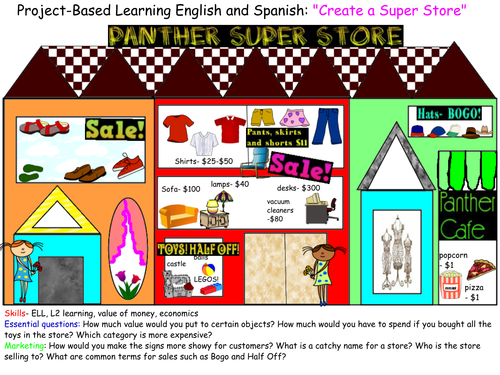
SWBAT:
Learn vocabulary on items found in stores
Research prices for items
Decide prices for different store items
Create a super store using a marketing and design plan
Use flaming text, cool text or other apps to create store "marketing material " such as signs
Use PPT, Pixie, Dreamweaver, or Drawpad to determine the best tools for graphic design
Follow the model provided.
** I did this lesson in two weeks, 50 mins to 1hr at a time.
Day 1:
I showed the model first, explained the vocab in it, and the purpose of the lesson. I also did a driverthrough of the technology to be used. Showed them the rubric, self-monitoring checklist, and assigned partners when needed (differentiation, ELL)
Day 2:
Reviewed, then modeled again how I use the vector art (or draw pad art) to create the rectangles, ovals, and other shapes that make the illusion of a department store. They can already be at the computer working along.
Day 3: I focus on vocabulary only, asking students first if they can recognize or attempt to pronounce the L2 words. Then we look for clipart of each word as we discuss it in the L2.
Day 4: Leeway day: Work on what you know so far. Look for preliminaries and how the students are understanding the project.
Day 5: Lesson on pricing, how it changes, and what costs what....and why. Exercises include conducting scavenger hunts of the same items sold in different locations and compare prices. Discuss price fluctuation. Discuss inflation. Discuss "budgeting". Why is it important? What are solutions to be prepared for inflation?
Day 6: Assigning prices. Showing a picture of a typical mall ask the students to "window shop" and assign value to the things they see.
Day 7: Marketing: How to promote an item, whether cheap or not? Lesson on marketing styles and examples of most popular marketing campaigns. Include: IKEA, Macy's, ETC.
With students
DaY 8: Leeway day: Keep working and creating using the info learned: vocab, pricing, design, marketing.
Day 9: Naming a store: What goes in a name? Lesson on BRANDING. Definition, examples, how to expose a brand, who exposes a brand, importance of keeping a brand influencing in a market; brand presence.
Day 10 : "Sloppy Copy" of all stores. All students to offer constructive criticism on each. Attach comments on sticky notes. Stores are to be identified by name only, not by students. Conversation with students.
Days 11 / 12: Leeway to add up everything. Math addition: Create purchase tickets and assign budgets to people in class. -13/14- Publish, show
Learn vocabulary on items found in stores
Research prices for items
Decide prices for different store items
Create a super store using a marketing and design plan
Use flaming text, cool text or other apps to create store "marketing material " such as signs
Use PPT, Pixie, Dreamweaver, or Drawpad to determine the best tools for graphic design
Follow the model provided.
** I did this lesson in two weeks, 50 mins to 1hr at a time.
Day 1:
I showed the model first, explained the vocab in it, and the purpose of the lesson. I also did a driverthrough of the technology to be used. Showed them the rubric, self-monitoring checklist, and assigned partners when needed (differentiation, ELL)
Day 2:
Reviewed, then modeled again how I use the vector art (or draw pad art) to create the rectangles, ovals, and other shapes that make the illusion of a department store. They can already be at the computer working along.
Day 3: I focus on vocabulary only, asking students first if they can recognize or attempt to pronounce the L2 words. Then we look for clipart of each word as we discuss it in the L2.
Day 4: Leeway day: Work on what you know so far. Look for preliminaries and how the students are understanding the project.
Day 5: Lesson on pricing, how it changes, and what costs what....and why. Exercises include conducting scavenger hunts of the same items sold in different locations and compare prices. Discuss price fluctuation. Discuss inflation. Discuss "budgeting". Why is it important? What are solutions to be prepared for inflation?
Day 6: Assigning prices. Showing a picture of a typical mall ask the students to "window shop" and assign value to the things they see.
Day 7: Marketing: How to promote an item, whether cheap or not? Lesson on marketing styles and examples of most popular marketing campaigns. Include: IKEA, Macy's, ETC.
With students
DaY 8: Leeway day: Keep working and creating using the info learned: vocab, pricing, design, marketing.
Day 9: Naming a store: What goes in a name? Lesson on BRANDING. Definition, examples, how to expose a brand, who exposes a brand, importance of keeping a brand influencing in a market; brand presence.
Day 10 : "Sloppy Copy" of all stores. All students to offer constructive criticism on each. Attach comments on sticky notes. Stores are to be identified by name only, not by students. Conversation with students.
Days 11 / 12: Leeway to add up everything. Math addition: Create purchase tickets and assign budgets to people in class. -13/14- Publish, show
Something went wrong, please try again later.
Thank you for sharing your resource. This resource has been recommended for teachers by the TES Resource Team.
Report this resourceto let us know if it violates our terms and conditions.
Our customer service team will review your report and will be in touch.
$2.50
